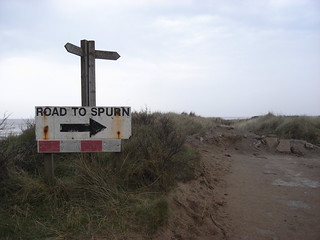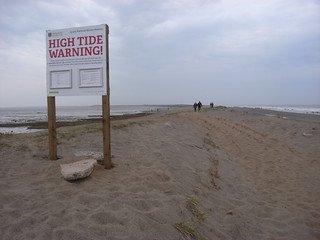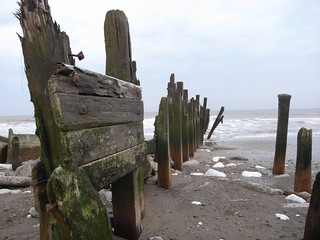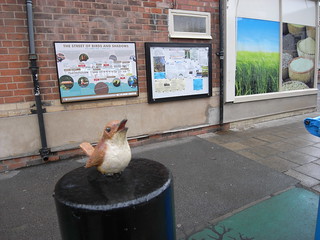On Easter Monday morning it was back to Hull, by train. I was hoping to get a bus but it was Sunday Service and the next one was a wait. Rick met me at the station and we headed off to Spurn Point, with a detour to
The Holly Tea Rooms in Patrington for a light lunch. My word, the portions were generous, and the tea came with its own matching set of crocks. I was mystified by the Xmas decorations, but then I got it - Holly! Well worth a detour.
 |
| Light lunch at Holly Tea Rooms |
The last time I came to Spurn Point (the second geographical extremity of the week) you could drive right down to the lighthouse, but not any more. You have to park up and walk. Soon the road runs out and there's just a sand bank, accessible only by 4x4s. Debris from the wartime defences is scattered everywhere, plus the remains of wooden breakwaters meant to tame the North Sea.
 |
| The road to nowhere |
 |
| Just a sand bar separates the North Sea from the River Humber |
 |
| Remains of wooden breakwaters |
After a bracing walk to this breach, we returned to a welcome cup of tea in the
Blue Bell Nature reserve cafe and back to Hull via the huge Centrica gas terminal and Withernsea. I wanted to see Holderness Road, as one of my ancestors Thomas Pipes lived there, according to the 1851 census. We also did a detour round the rather attractive Garden Village behind Holderness House. Hull has many parks! Thence back to Rick's for fish curry.
 |
| An Ella Street bird |
Tuesday morning we travelled into Hull to visit the
Ferens Art Gallery, which has a fine collection of Victorian and Edwardian paintings, and a great modern collection too. The Hull Open was on, and there were some items I wouldn't mind having on my walls. On the way we checked out The Street of Birds and Shadows, Ella Street, where Rick used to live. There are plenty of metal birds to spot all along the way.
Art Galleries often have good cafes, and this was no exception. Rick dropped me off at the Hull History Centre, where I had to deposit my bag and get a temporary readers ticket to study the directories (only pencils allowed). I found no trace of Thomas Pipes but a librarian (?) suggested he lived by a steam mill (he was a stoker, and I'd always assumed that was aboard a ship) crushing linseed. Bell's Mill was the best candidate, but it wasn't named on any of the maps. Just as I was leaving, she found a book on Holderness Road which had more info on Bell's oil mill, more grist for David Pipes in Kent, our family historian, to digest!





No comments:
Post a Comment